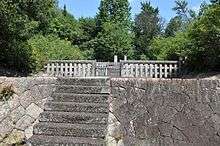Matsudaira Yorihiro (Takamatsu)
| Matsudaira Yorihiro | |
|---|---|
| Lord of Takamatsu | |
 Grave of Matsudaira Yorihiro, Reishiji cemetery of Matsudaira family | |
| Reign | 1642–1673 |
| Predecessor | Matsudaira Yorinori |
| Successor | Matsudaira Yoritane |
|
Issue
Ōkubo Tadanori | |
Matsudaira Yorihiro (松平頼恕, 1798–1842)[1] was a Japanese daimyō of the late Edo period, who ruled as the ninth lord of the Takamatsu Domain.
Yorihiro ordered Mifuyu Tomoyasu, a scholar of Kokugaku (National Learning), to compile a book called Rekicho Yoki, and he presented it to the Imperial court.[2]
One of Yorihiro's sons was Ōkubo Tadanori. His descendant Yorihiro Matsudaira, named after him, was a notable figure of Japanese Scouting and recipient of the Bronze Wolf.
References
- ↑ http://www.morishige-furniture.co.jp/urushi-kagawa/sanuki-e.html Sanukibori Development of Technique "During the years of the Kansei period, (1789–1802) the master craftsmen of tsuishu and tsuikoku, Zokoku Tamakaji is said to have initiated this art. From his early years, Tamakaji, along with studying the lacquer industry and carrying on his father Rizaemon's work, also studied engraving and in the 10th year of the Tenpo Period (1839), at the age of 33 he sculpted 1806 pieces of flowers, birds and insects. Matsudaira Yorihiro (1798–1842) rewarded Zokoku with samurai status in 1835 in recognition of his impressive work and gave him the name Tamakaji in 1839. Lord Yorihiro allowed him to use a sword on rhinoceros horn pieces because of his talent."
- ↑
- http://www.city.takamatsu.kagawa.jp/kyouiku/bunkabu/rekisi/NAIYOU/yuisyo/kakukou/matu.htm
- http://www.kcn-net.org/bunjo/eishoji/okatsu.htm
- http://omugio.exblog.jp/page/54/ samurai jp
- http://www.wul.waseda.ac.jp/kotenseki/search.php?cndbn=%95%BD%96%EC+%8C%BA%8A%B2
| Preceded by Matsudaira Yorinori |
1st Daimyō of Takamatsu (Mito-Matsudaira) 1642–1673 |
Succeeded by Matsudaira Yoritane |
This article is issued from
Wikipedia.
The text is licensed under Creative Commons - Attribution - Sharealike.
Additional terms may apply for the media files.